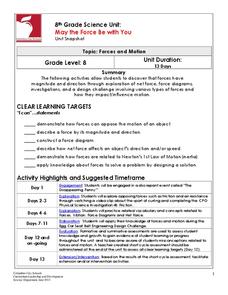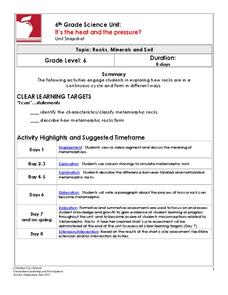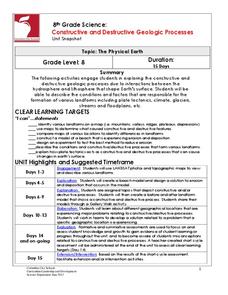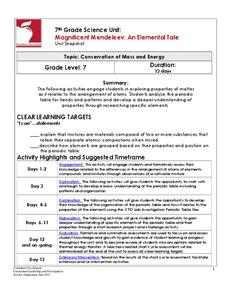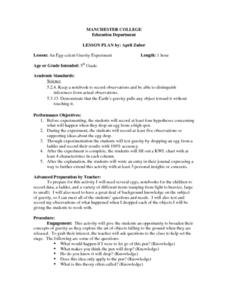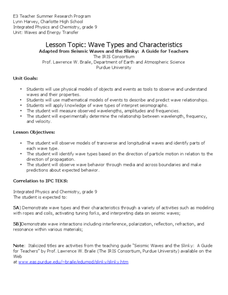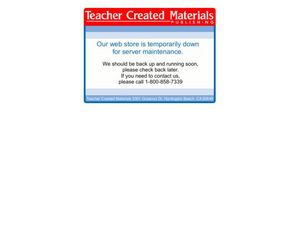Columbus City Schools
Planet X
How did the earth become the mass that it is now? Your young scientists explore this question through the concept of density. Their inquiries consider the impact of gravity on the formation of planets. The culminating activity of the...
Columbus City Schools
It’s All Relative
Are the people on the other side of the world standing upside down? Pupils discuss the relationship between movement and position words. The unit explores the concept of reference points through animation, modeling, photography, and...
Columbus City Schools
May the Force Be with You
You won't have to force your classes to complete these engaging activities! Through exploration, young scientists learn that force has both magnitude and direction. They draw force diagrams, investigate force models, and complete a...
Columbus City Schools
Sedimentary Rocks
Turn your class discussion of rock formation from ho-hum to holy hornfels! Junior geologists gain experience in identifying rock types and rock origins, with an emphasis in hypothesizing the environment needed to form certain...
Columbus City Schools
What is Up Th-air? — Atmosphere
Air, air, everywhere, but what's in it, and what makes Earth's air so unique and special? Journey through the layers above us to uncover our atmosphere's composition and how it works to make life possible below. Pupils conduct...
Columbus City Schools
It's the Heat and the Pressure?
Ready for a change? Give a comprehensive collection of metamorphic materials a try! With the assortment of printables and lab activities, you won't be under pressure to keep things lively. The unit culminates by having...
Columbus City Schools
It’s Electric!
Shocking! Who knew so many great ideas existed for teaching middle schoolers about electricity? Find them all within this energetic framework. You'll light up at the variety of printable and web-based resources within! After building...
Columbus City Schools
Constructive and Destructive Geologic Processes
Show the class the world as they've never seen it before—from way above! Learners try to unravel the mysteries presented by rich satellite imagery, learn to interpret topographic maps, and study erosion by constructing their very...
Columbus City Schools
Magnificent Mendeleev: An Elemental Tale
Discover how the periodic table tells the story of its elements. Learners begin by studying the makeup of several mixtures. Their analysis leads to a discussion of elements and the periodic table. As they dig deeper, they understand the...
Teach Engineering
Flow Rates of Faucets and Rivers
Go with the flow and use a helpful resource. A set of two activities has learners investigate flow rates. They first determine the flow rate of a faucet by measuring how long it takes to fill a bucket. Using the results, they make a...
Science 4 Inquiry
Battle of the Waves
Which travels faster, light or sound? Scholars work in groups to simulate the ability for waves to travel through solids, liquids, gases, and through a vacuum. Then, they learn about the properties of a mystery wave and must determine...
Curated OER
Folds in the Earth
Ninth graders demonstrate the forces that cause folds in the earths crust by use of clay modeling. They demonstrate there knowledge of terminology and concepts related to Earths folding processes by a written or oral report on data...
Curated OER
You are the Microbiologist
In this lesson, students demonstrate comprehension of basic lab techniques by properly using these techniques in preparing a laboratory investigation, demonstrate synthesis of prior lab experiences by solving a new problem using those...
Curated OER
Biogeochemical Cycles
Students demonstrate comprehension of the energy sources of various cycles by completing mini stories. They demonstrate analysis of words by defining individual word parts and combining them to form definitions. Students demonstrate...
Curated OER
An Egg-celent Gravity Experiment
Fifth graders record at least four hypotheses concerning what happens when they drop an egg from a high spot. They record at least five observations or supporting ideas about the egg drop. Students test gravity by dropping an egg from a...
Curated OER
Perceiving the Prairie
Twelfth graders explore the changing concept of "prairie" through written and artistic works. They write their own poem or essay describing the prairie after discussing how differently people perceive the prairie.
Curated OER
Wave Types and Characteristics
Ninth graders identify the different parts of a wave. In this physics instructional activity, 9th graders observe wave behavior as it travels through a boundary. They determine the relationship between wavelength, frequency and...
Curated OER
Alice Computer Programming
Students explore multimedia components. In this science inquiry lesson, students read "Invitation to the Game" by Monica Hughes and they use the Alice Computer Programming System to better understand population dynamics.
Curated OER
Thanks Be To You
Students research U.S. history by completing a worksheet activity in class. In this historical figure lesson, students identify the contributions and risks taken by the former African-American leader Martin Luther King Jr. Students read...
Curated OER
What is Biocomplexity?
Students dicuss different aspects of biocomplexity. They demonstrate synthesis of complex concepts by creating before and after posters expressing how the concepts of biocomplexity have ben internalized. Students define the term...
Curated OER
Colorimetric Assay
Students review the basic lab techniques by following lab procedures. They analyze data by using raw data gathered. Students comprehend the processes occurring inside the column. They use specific chemicals to help determine the...
Curated OER
Winogradsky in a Bottle: Beginning a Winogradsky Column
Students use their measurement skills by marking a bottle for construction purposes. They record qualitative and quantitative data and analyze their results. Students demonstrate evaluation of a small scale systems as a model for the...
Curated OER
Exploring Stars
Fifth graders explore the life cycle of stars. They analyze small, medium, and large stars and view a video that compares the life cycles of the various sized stars. They create a flipbook movie detailing the life cycles of a star and...
Curated OER
Predicting Molecular Shapes
In this molecular shapes worksheet, students read about how to predict molecular shapes in molecules based on the number of electron pairs and the VSEPR theory. Students are given twelve molecules, they draw the Lewis structures and...


